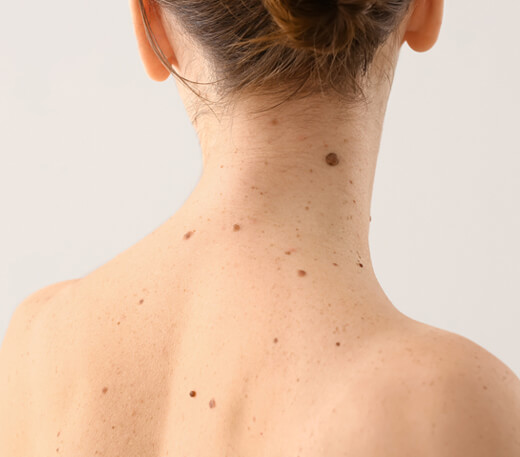
What are Skin Growths?
Skin growths are a benign condition that consists of a lump of tissue projecting out from surrounding skin. The most common skin growths are:
Moles: Moles are small skin marks caused by pigment producing cells in the skin. They can be flat or raised, smooth or rough, and some contain hair. They may occur anywhere on the body. Most are dark brown or black, but some are flesh-colored, red or yellow. They can change in appearance over time. Some can develop into cancer. Benign moles are generally smaller than the size of a pencil eraser.
Warts: Warts are a harmless skin growth caused the human papilloma virus. Warts can be spread to other parts of the body or to other people by contact. Warts are slow growing and range in appearance from papules and plaques to large, flowering cysts with tiny black dots. Warts can grow anywhere on the body. Warts are most common among children and young adults. There are five kinds of warts:
- Common warts are rough, shaped like a dome, and gray-brown in color. They appear most often on the hands.
- Plantar warts grow on the soles of the feet. They look like hard, thick patches of skin with dark specks and may be hidden beneath calluses. Plantar warts may cause pain when you walk.
- Flat warts grow on the face, hands, arms or legs. They are normally smaller size of a pencil eraser, have flat tops, and can be pink, light brown or light yellow.
- Filiform warts usually grow around the eyes, mouth, nose, or beard area. They are the same color as the skin and have growths that look like fingers or threads sticking out of them.
- Periungual warts grow under and around the toenails and fingernails. They look like rough bumps with an uneven surface and border.
Skin tags: Skin tags are projections of smooth or irregular skin, flesh-colored or more deeply pigmented, projecting from surrounding skin, often connected by a narrow stalk to the surrounding skin. They often appear around the eyelids, neck, groin, underarms and under the breasts. They are usually painless, but may become irritated and itch.
What are Skin Growths?
Most skin growths are benign and harmless. However in some cases it’s important to determine if certain moles are benign or cancerous. Some benign growths can indicate a systemic condition, including hormonal disorders. Most benign growths do not require treatment unless they produce symptoms. A skin biopsy may be needed to evaluate lesions that have changed or that display characteristics of malignancy.
Do’s and Don’ts
Do…
- Consult a doctor about removing any skin tags, warts or especially moles.
- Consult a doctor if you notice any change in your skin growths, including increase in size, change in color, pain, bleeding, cracking or oozing.
- Be careful treating warts with over-the-counter drugs, particularly genital warts, which are best treated by a doctor.
- Keep the skin clean and moisturized.
Don’t…
- Pick at moles, warts or skin lesions to prevent infecting the area and worsening the condition.
- Get impatient. Home remedies can take days or weeks to work. Again, in most cases it’s best to consult a doctor.
Treatment Options
- Cryosurgery
- Dermabrasion
- Desiccation


